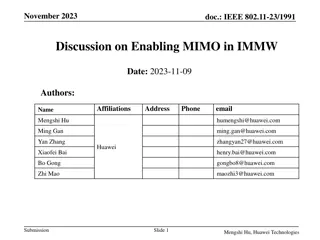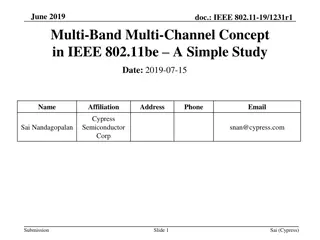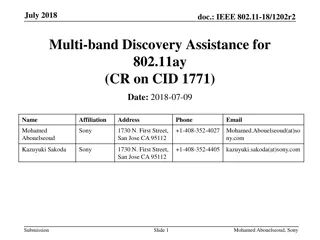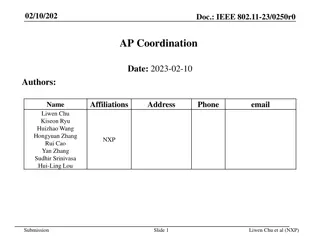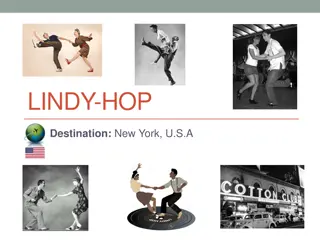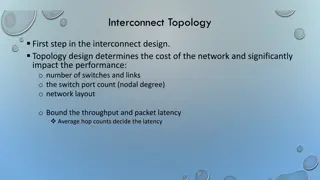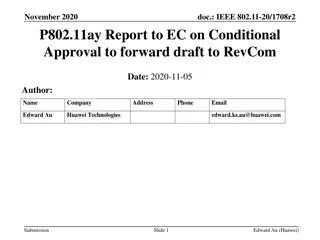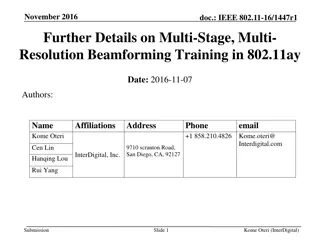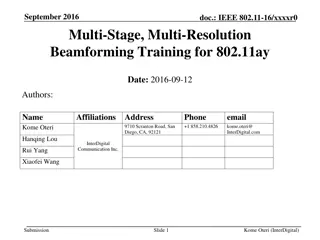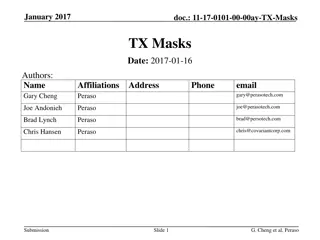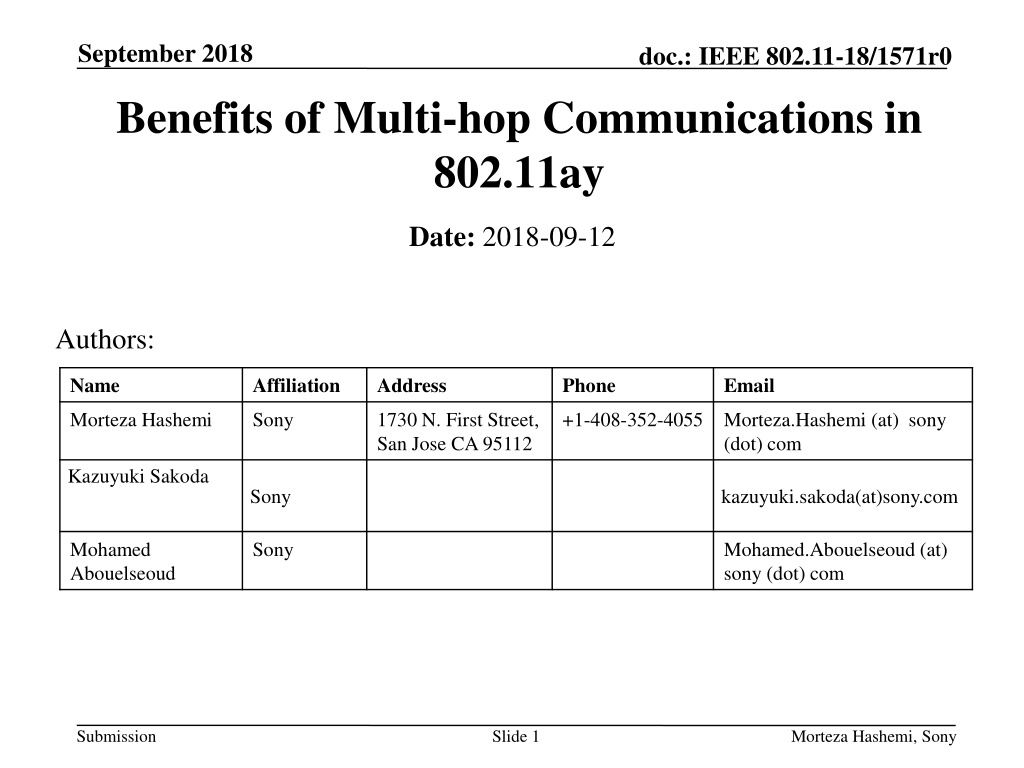
Benefits of Multi-hop Communications in IEEE 802.11ay
Explore the advantages of multi-hop communications in the context of IEEE 802.11ay, focusing on high-throughput and low-latency for consumer devices. Simulation results demonstrate the benefits for next-generation 60GHz communications, addressing challenges like human blockage and limited coverage by enabling multi-hop capability in devices.
Download Presentation

Please find below an Image/Link to download the presentation.
The content on the website is provided AS IS for your information and personal use only. It may not be sold, licensed, or shared on other websites without obtaining consent from the author. If you encounter any issues during the download, it is possible that the publisher has removed the file from their server.
You are allowed to download the files provided on this website for personal or commercial use, subject to the condition that they are used lawfully. All files are the property of their respective owners.
The content on the website is provided AS IS for your information and personal use only. It may not be sold, licensed, or shared on other websites without obtaining consent from the author.
E N D
Presentation Transcript
September 2018 Benefits of Multi-hop Communications in 802.11ay doc.: IEEE 802.11-18/1571r0 Date: 2018-09-12 Authors: Name Affiliation Address Phone Email Morteza Hashemi Sony 1730 N. First Street, San Jose CA 95112 +1-408-352-4055 Morteza.Hashemi (at) sony (dot) com Kazuyuki Sakoda Sony kazuyuki.sakoda(at)sony.com Mohamed Abouelseoud Sony Mohamed.Abouelseoud (at) sony (dot) com Submission Slide 1 Morteza Hashemi, Sony
September 2018 doc.: IEEE 802.11-18/1571r0 Agenda Motivation and Highlight Recap on Consumer Device Use Cases Usage Model 3: AR/VR Headsets Simulation Setup and Results Observations Usage Model 2: 8K UHD Wireless Transfer Simulation Setup and Results Observations Conclusion Submission Slide 2 Morteza Hashemi, Sony
September 2018 doc.: IEEE 802.11-18/1571r0 Motivation 802.11ay use case document [1] contains the list of use cases for next generation 60GHz communications, including consumer device use cases High-throughput and low-latency are critical for consumer devices use cases Challenges: (1) Human blockage; (2) Limited coverage This contribution provides simulation results to demonstrate benefits of multi-hop communications for 802.11ay Submission Slide 3 Morteza Hashemi, Sony
September 2018 doc.: IEEE 802.11-18/1571r0 Highlight: Multi-hop is beneficial Enabling multi-hop capability in 802.11ay devices mitigates the effects of human blockage and provides an extended range of communications (beyond LOS) Source Sink Relay device Submission Slide 4 Morteza Hashemi, Sony
September 2018 doc.: IEEE 802.11-18/1571r0 Recap on Consumer Device Use Cases UM3 and UM2 in [1] reflect typical usage and requirements for consumer applications UM2: 8K UHD wireless transfer at Smart Home UM3: AR/VR headsets and other high-end wearables Submission Slide 5 Morteza Hashemi, Sony
September 2018 doc.: IEEE 802.11-18/1571r0 Recap on Consumer Device Use Cases Use case and requirement matrix is shown below Use case Application Venue Range Bandwidth Latency VR headset Video streaming Video streaming Indoor 5-10m (~20m) >Gbps <5msec UHD transfer Indoor 5-10m (~20m) >Gbps <5msec Morteza Hashemi, Sony Submission Slide 6
September 2018 doc.: IEEE 802.11-18/1571r0 Usage Model 3: AR/VR Headset UM3: AR/VR headset For now, game is the prominent application of VR Game console and VR headset may be located in the same room However, console and headset might not be in LOS or may suffer human blockage Submission Slide 7 Morteza Hashemi, Sony
September 2018 doc.: IEEE 802.11-18/1571r0 Usage Model 3: AR/VR Headset Requirements: High-throughput; low-latency Challenge: Human blockers Source (Console) Sink (Headset) Blockers move Leveraging multi-hop capability to combat human blockage Submission Slide 8 Morteza Hashemi, Sony
September 2018 doc.: IEEE 802.11-18/1571r0 Simulation Setup 802.11ad SC PHY with performance shown in 11-10/431r3 PHY Simulations and Methodology [2], AWGN case STA with Tx power of 18dBm Human blockage: Simulated as an additional path loss Surface loss of 6dB; Inner loss of 25dB Body dimensions: length: 0.5m; width: 0.5m; height: 1.8m Channel access is based on CBAP, and TXSS is performed for each BHI BI = 100ms; BHI = 5ms; DTI = 95ms STA generates unidirectional traffic of 1.2Gbps Buffer size of 8MB for STAs Submission Slide 9 Morteza Hashemi, Sony
September 2018 doc.: IEEE 802.11-18/1571r0 Simulation Setup Before accessing channel, STAs perform CCA using omni RX pattern (0dBi) PD is set to -68dBm, where noise level equals to -70.6dBm (-174 dBm/Hz thermal noise; 1.76GHz BW; NF=10dB; 1dB additional loss) Energy detection (ED) threshold is set to -48dBm Given PHY performance model and PD level, link budget is restricted by PD level MCS selection activated with ARF Use RTS/CTS all the time, performing omni CCA before the beginning of TXOP All the frames (RTS/CTS/Data/BACK) are transmitted with Beamforming RX BF is operated after transmitting/receiving RTS frame RTS/CTS frame are transmitted with MCS4 All the traffic are transmitted with AC=BE (EDCA) 1500 octet datagram, up to 64 A-MPDU, TXOP duration up to 300usec Submission Slide 10 Morteza Hashemi, Sony
September 2018 doc.: IEEE 802.11-18/1571r0 Simulation Scenario 1 Source (i.e., Node 1) 1 Sink (i.e., Node 6) 1 relay (i.e., Node 4) Single human blocker Blocker moves and blocks the link between Node 1 and Node 6 for 1 seconds. Blocker Submission Slide 11 Morteza Hashemi, Sony
September 2018 doc.: IEEE 802.11-18/1571r0 Propagation Model We use ray-tracing with the following configurations: Number of computed paths: 25 Number of reflections: 3 Number of diffraction: 1 Number of transmissions: 3 Submission Slide 12 Morteza Hashemi, Sony
September 2018 doc.: IEEE 802.11-18/1571r0 Simulation Scenario Node 6 Case 1: Single-hop communications only Direct link from Node 1 to Node 6 Node 4 Blocker Node 1 Node 6 Case 2: Dynamic Multi-hop communications Node 1 dynamically adjusts and chooses its next hop based on a link condition when the ongoing link is blocked Blocker Node 4 Node 1 Submission Slide 13 Morteza Hashemi, Sony
September 2018 doc.: IEEE 802.11-18/1571r0 Simulation Scenario Key Performance Indicators: ???????? ?????????????? Throughput = Delay: end-to-end delay from Node 1 to Node 6 Delay CDF: Cumulative distribution of delay Durations: Simulation: 4 seconds 1.2Gbps traffic generated at Node 1 from 1 to 3 second Link between Node 6 and Node 1 is blocked from 2 and 3 second. Submission Slide 14 Morteza Hashemi, Sony
September 2018 doc.: IEEE 802.11-18/1571r0 Simulation Results: Throughput Case 1: Single-hop Case 2: Dynamic Multi-hop Multi-hop maintains high-throughput performance Blocked by human body Submission Slide 15 Morteza Hashemi, Sony
September 2018 doc.: IEEE 802.11-18/1571r0 Simulation Results: Delay CDF Case 1: Single-hop Case 2: Dynamic Multi-hop 90th percentile ~ 2ms 98th percentile ~ 5ms Submission Slide 16 Morteza Hashemi, Sony
September 2018 doc.: IEEE 802.11-18/1571r0 Simulation Results: Delay Case 1: single-hop Case 2: Dynamic Multi-hop Delay spikes: BHI effect Delay spikes: BHI effect Time switched to multi-hop No data was received Submission Slide 17 Morteza Hashemi, Sony
September 2018 doc.: IEEE 802.11-18/1571r0 Observations Dynamic multi-hop provides a reliable and robust high-throughput solution. Delay performance is (mostly) under 5ms. High delay spikes are due to BHI overhead. To improve the delay performance, we should minimize the BHI overhead. Submission Slide 18 Morteza Hashemi, Sony
September 2018 doc.: IEEE 802.11-18/1571r0 Usage Model 2: 8K UHD Wireless Transfer UM2: UHD for display The goal of UM2 is to eliminate or reduce ugly cables, and give users flexibility of device installation Morteza Hashemi, Sony Submission Slide 19
September 2018 doc.: IEEE 802.11-18/1571r0 Usage Model 2: Challenges STB/Tuner might be located places where LOS signal cannot travel STB/Tuner might be located behind sofa and/or humans Morteza Hashemi, Sony Submission Slide 20
September 2018 doc.: IEEE 802.11-18/1571r0 Simulation Scenario Case 1: Source -> Sink Case 2: Source -> Relay -> Sink Case 1 Case 2 Submission Slide 21 Morteza Hashemi, Sony
September 2018 doc.: IEEE 802.11-18/1571r0 Simulation Results: Throughput Case 1: Single-hop Case 2: Multi-hop Multi-hop provides range extension. No coverage with single-hop. Submission Slide 22 Morteza Hashemi, Sony
September 2018 doc.: IEEE 802.11-18/1571r0 Simulation Results: Delay Case 2: Multi-hop Delay spikes: BHI effect Submission Slide 23 Morteza Hashemi, Sony
September 2018 doc.: IEEE 802.11-18/1571r0 Observations Dynamic multi-hop provides 60GHz communications beyond LOS. Delay performance is (mostly) under 6ms (98th percentile) High delay spikes are due to BHI overhead To improve the delay performance, we should shrink the BHI overhead. Submission Slide 24 Morteza Hashemi, Sony
September 2018 doc.: IEEE 802.11-18/1571r0 Conclusion Revisited consumer device use cases: Latency, robustness, and flexibility of device installation are important for these use cases 802.11ay device should leverage multi-hop capability: To mitigate the effects of human blockers To enable beyond LOS communications (e.g., room-to-room) Multi-hop communications is beneficial to combat with blocker and extended communication coverage Submission Slide 25 Morteza Hashemi, Sony
September 2018 doc.: IEEE 802.11-18/1571r0 References [1] IEEE 802.11-15/0625r7 IEEE 802.11 TGay Use Cases [2] IEEE 802.11-10/431r3 PHY simulations and Methodology , Shadi Abu-Surra, et.al. Submission Slide 26 Morteza Hashemi, Sony





